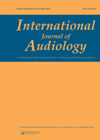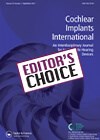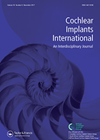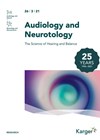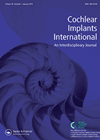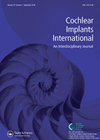
Journal Reviews
Third-party disability in cochlear implant users
Hearing loss causes changes for those experiencing it and the people who share in their everyday lives, often referred to as third party disability or caregiver burden. This study emphasises the notion that this phenomenon can be considered a disability,...
MRI scanning patients with cochlear implants and auditory brainstem implants
In the last five to six decades, MRI scanning has gone from physics experiments in Nottingham University through to Nobel prize-winning work by Sir Peter Mansfield and Paul Lauterbur, to a ‘routine’ imaging modality with an estimated 60 million MRI...
Music training for cochlear implant users
The ability to enjoy music is something that is important to most people and contributes to wellbeing, as well as holding cultural significance. However, the speech signal is generally prioritised for those with cochlear implants (and indeed hearing aids). Improving...
Electrocochleography and cochlear implants programming
Cochlear implants (CIs) often are the only option for people with severe to profound sensorineural hearing loss to be able to hear. Therefore, effective CI programming seems very important, especially in children who are still developing their speech. Using acoustic...
Impedance for different electrode types
Measuring cochlear implant (CI) electrode impedances is common in CI programming appointments to measure the integrity of the implant e.g. whether there are any open or short electrodes. This is because impedance measures the flow of current between intra and...
Moving towards implanting children below 12 months of age
Newborn hearing screening has ensured that deaf infants are identified soon after birth so that habilitation can begin as early as possible. Cochlear implantation is a key component of early intervention for some children, but it is often not performed...
Cochlear implantation in asymmetric hearing loss
Criteria for cochlear implantation (CI) is a constant topic of debate. The UK traditionally had relatively restrictive guidance, although this has been greatly improved by more recent guidance released in 2019. Nevertheless, because of the lack of evidence for cost-effectiveness,...
Robotic insertion of electrode array in cochlear implantation
Cochlear implants (CIs) are commonly used for profound bilateral hearing loss. They have specific national guidance for their insertion, however patients with a substantial residual acoustic hearing are potential CI candidates. Preservation of this residual hearing can be sought with...
Cochlear implantation following radiotherapy treatment of vestibular schwannomas
The authors presented a case report and systematic review assessing the outcomes of patients from cochlear implantation (CI) following radiotherapy treatment for vestibular schwannoma (VS). Outcomes of cochlear implantation in these patients are uncertain due to the combination of both...
The impact of bilateral implantation on language outcomes
An American study retrospectively looked at the language outcomes of 204 children implanted either bilaterally, sequentially or unilaterally. All children received their first implant before the age of three years, and language measures were collected when the children were aged...
Recording of electrode voltages (REVS) to determine extra-cochlear electrodes
Determining whether electrodes are sitting within the cochlea can be difficult as the checks run by the programming software cannot always determine this. In some cases, patients may be unable to give the audiologist detailed feedback which can complicate the...
Cobalt hip implants and auditory-vestibular outcome
Cobalt-chromium (Co-Cr), metal-to-metal hip implants were commonly used until several side-effects were reported due to an increased level of Co and Cr metal ions in patients’ blood. Although this type of hip replacement was almost completely abandoned, there are still...

